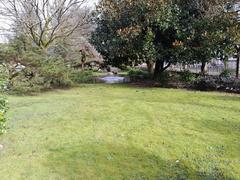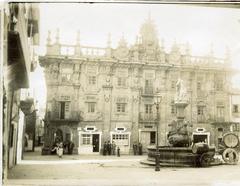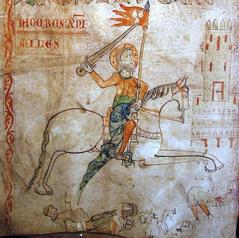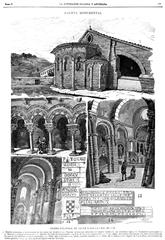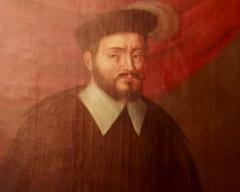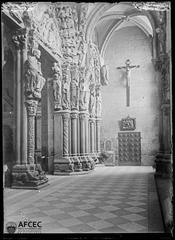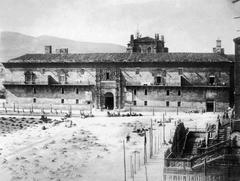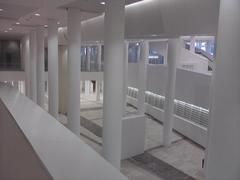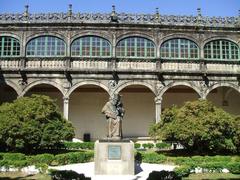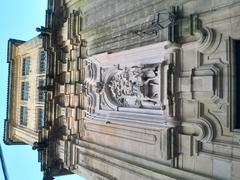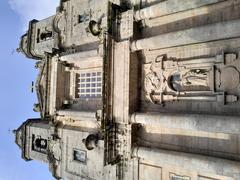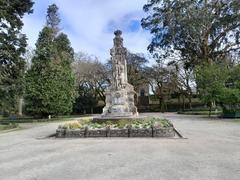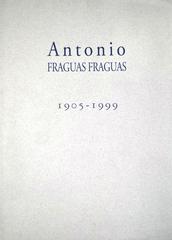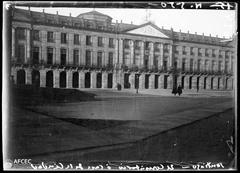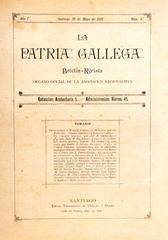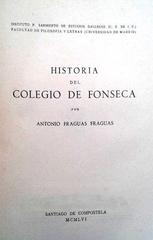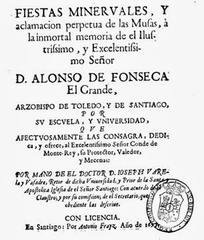
Convento De Santa Clara De Santiago De Compostela
Convento de Santa Clara de Santiago de Compostela: Visiting Hours, Tickets, and Travel Guide
Date: 03/07/2025
Introduction
Set just outside the medieval walls of Santiago de Compostela, the Convento de Santa Clara stands as a striking emblem of Galicia’s religious, architectural, and cultural heritage. Founded in 1260 by the Order of Saint Clare (Poor Clares) with royal support from Queen Violante of Aragón, the convent has been a vital spiritual and historical landmark along the Camino de Santiago. Its harmonious blend of medieval Gothic austerity and 17th–18th century Galician Baroque grandeur, alongside its continuing religious life and artisanal traditions, make it an essential stop for history lovers, pilgrims, and cultural travelers alike (Santiago Turismo, Galicia Guide, compendium16.blogspot.com).
This guide covers the convent’s rich history, unique architecture, spiritual significance, visitor information (including hours, tickets, and accessibility), and tips for making the most of your visit to this remarkable Santiago de Compostela historical site (Turismo de Santiago, caminodesantiago.gal).
Table of Contents
- Historical Overview
- Religious and Cultural Significance
- Architectural Highlights
- Visitor Information
- Nearby Attractions
- Special Events and Local Customs
- Frequently Asked Questions
- Conclusion and Travel Tips
- References
Historical Overview
Foundation and Early History
The Convento de Santa Clara was established in 1260, during a period of expanding female monasticism in Galicia. Supported by nobility and church authorities—including Queen Violante of Aragón—the convent offered a cloistered, contemplative haven for women seeking a spiritual life of poverty and devotion (Santiago Turismo, Declausura). Its location near the historic Porta da Pena, on the Camino de Santiago, made it an integral part of the city’s religious and social fabric.
Architectural Evolution
- Medieval Origins: The earliest structures display Gothic influences, such as pointed arches and ribbed vaults, reflecting the Poor Clares’ values of simplicity and humility (Galicia Guide).
- Baroque Transformation: During the 17th and 18th centuries, the convent underwent major renovations. The striking Baroque façade and the ornate church altar, attributed to Simón Rodríguez and Domingo de Andrade respectively, are prime examples of Galician Baroque (compendium16.blogspot.com, Turismo de Galicia).
- Modern Preservation: Recent efforts have focused on conserving the convent’s monumental architecture and adapting certain areas for cultural events, while respecting the privacy of its cloistered community (La Voz de Galicia).
Religious and Cultural Significance
Spiritual and Social Role
The convent has continuously housed a community of Poor Clares, who adhere to a life of prayer, work, and charity. As of 2025, thirteen nuns maintain the tradition of daily liturgical prayer, manual labor, and hospitality toward pilgrims (Declausura). The church is dedicated to the Immaculate Conception and features daily Mass at 19:00 and the Rosary at 18:30 (horariosmisa.es).
Connection to the Camino de Santiago
Located directly along the northern approach of the Camino de Santiago, the convent has historically served as a spiritual stop for pilgrims on their way to the Cathedral of Santiago (ilovecompostela.com). The nuns’ tradition of welcoming pilgrims continues, offering a space for prayer, reflection, and the purchase of convent-made sweets—an enduring part of their hospitality.
Artisanal Traditions
Following the Rule of Saint Clare, the nuns support themselves through the creation of liturgical textiles, embroidery, and the renowned production of Galician pastries and sweets, available for purchase through the convent’s “torno” (turnstile) (Paxinas Galegas). This fosters a unique connection between the cloistered community and visitors.
Architectural Highlights
The Baroque Façade
The convent’s “fachada-telón” (curtain façade) was completed in 1719 by Simón Rodríguez. Crafted from local granite, its grand verticality, dynamic ornamentation, and prominent statue of Saint Clare exemplify the exuberance of Galician Baroque (compendium16.blogspot.com, Wikipedia GL). The façade’s elaborate stonework, with floral motifs and angelic forms, is designed to inspire awe and spiritual elevation.
Church Interior and Altarpiece
The church features a magnificent Baroque retablo by Domingo de Andrade, completed in 1700. This gilded altar, adorned with statues of Saint Clare, Saint Francis, and Saint Anthony, is a focal point for both worship and art appreciation (Santiago Turismo). Additional Churrigueresque-style side altars and original medieval elements—such as granite pulpits—enrich the interior.
Cloister and Monastic Spaces
The convent’s cloister, with its harmonious arcades and tranquil garden, embodies the contemplative ideals of the Poor Clares. While most cloistered areas are not open to the public, their design and preservation remain central to the convent’s spiritual mission.
Visitor Information
Location
- Address: Rúa San Roque, s/n, 15704 Santiago de Compostela, A Coruña (Google Maps)
- Easily accessible on foot from the city center and the Cathedral.
Visiting Hours
- Church Access: Open to the public before and after liturgical services—typically 8:30–9:30 (morning) and 18:00–19:30 (evening).
- Torno (Sweets Sales): 9:30–12:30 and 16:30–18:00.
- Note: Visiting hours may vary on religious holidays or during special events. Consult local tourism offices or horariosmisa.es for updated schedules.
Tickets and Fees
- Admission: Free for attending Mass, Rosary, or purchasing sweets. Donations are appreciated to support preservation and community activities.
- Guided Tours: The convent does not offer regular guided tours due to its cloistered status. Limited interior access may be possible during special events—check with Santiago Turismo for updates.
Accessibility
- Wheelchair Access: The exterior and main church entrance have partial accessibility; interior spaces are limited due to historic architecture.
- Assistance: Visitors with special needs should contact the convent or local tourist offices in advance.
Dress Code and Etiquette
- Dress modestly: Shoulders and knees covered.
- Silence: Maintain silence, especially during services.
- Photography: Not allowed inside the church or cloistered areas; exterior photography is permitted.
Nearby Attractions
The Convento de Santa Clara’s location allows easy exploration of other Santiago de Compostela historical sites:
- Cathedral of Santiago de Compostela: Iconic pilgrimage destination, renowned for its Romanesque and Baroque architecture.
- Museo do Pobo Galego: Celebrates Galician culture and history.
- Parque de Bonaval: A tranquil green space nearby.
- Museo de las Peregrinaciones: Focused on the Camino de Santiago (Museo de las Peregrinaciones).
Special Events and Local Customs
The convent participates in local festivals, such as the Fiestas de la Ascensión and Día das Letras Galegas, and maintains unique traditions, including the custom of offering eggs to the nuns to pray for good weather on wedding days (Santiago Turismo).
Frequently Asked Questions (FAQ)
Q: What are the Convento de Santa Clara visiting hours?
A: The church is open before and after daily Mass (typically 8:30–9:30 and 18:00–19:30). Sweets sales are 9:30–12:30 and 16:30–18:00.
Q: Is there an entrance fee?
A: No; entry is free. Donations are welcome.
Q: Are guided tours available?
A: Not on a regular basis, but may be offered during special events.
Q: Is the convent accessible for visitors with disabilities?
A: Exterior areas and the main church entrance have partial access; interiors may be difficult to navigate.
Q: Can I buy souvenirs or sweets?
A: Yes, at the torno during its operating hours.
Q: Is photography allowed?
A: Only outside; photography is not permitted inside to respect the cloistered community.
Conclusion and Travel Tips
The Convento de Santa Clara is a living monument—an active center of contemplative life, historic art, and Galician tradition. Whether you come as a pilgrim, history lover, or cultural explorer, you’ll find a welcoming, serene environment steeped in centuries of heritage. For an enriching experience:
- Verify opening hours and special events in advance.
- Arrive early for Mass or the sweets sales for a quieter atmosphere.
- Respect the convent’s contemplative character.
- Explore nearby historical sites and sample the convent’s renowned pastries.
For up-to-date information, guided audio tours, and more recommendations on Santiago de Compostela historical sites, download the Audiala app and follow us on social media.
References and Further Reading
- Santiago Turismo
- Caminodesantiago.gal
- Santiago Turismo - Convento de Clausura de Santa Clara
- ilovecompostela.com
- La Voz de Galicia
- Turismo de Galicia
- compendium16.blogspot.com
- Declausura.org
- horariosmisa.es

